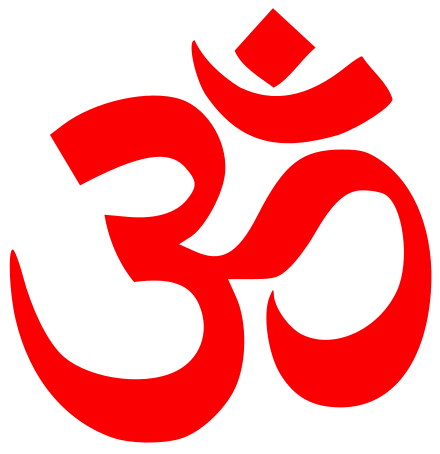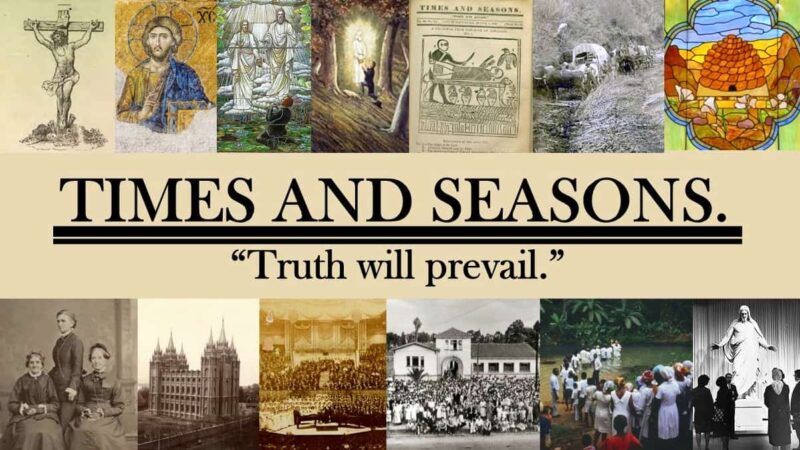
Om, the vocal essence of the universe according to various South Asian religions
Even if one does not accept the Church’s truth claims, it clearly has a knack for tapping into deep, primordial religious themes and principles that pop up across time and space. One of these is what I’m going to call capital-S and lowercase-s sacred objects and symbolism. (There may be a more formal term in the anthropology of religion for this distinction that I’m not aware of, but these terms should suffice for our purposes).
The lower-case s sacred symbols and objects are ones that we would not feel any compunction about throwing in the dumpster if they were worn out. In our own case, if a pamphlet with the Church’s name in the official typography was torn up, I wouldn’t feel any hesitation about throwing it out in the way that I would with, for example, temple garments, which have more of a per se, intrinsic, capital-S Sacredness. (The distinction I’m drawing here perhaps fits into the Pacific Island religious concept of tapu that denotes the same intrinsic Sacred apartness, and yes, that’s the word from which we get taboo, but the English word has come to mean something different).
I’ll even go so far as to say that the sacrament bread as a symbol fits into the former category, as the deacons throw it out once it’s done. For Catholics, however, there is a whole process for respectfully disposing of blessed communion wafers akin to our process of disposing of old garments. (Even the term “symbol” can be a misnomer, as a symbol represents something else, whereas for Catholics the Eucharist is the thing itself.) Similarly, Orthodox icons and Hindu statues have an embedded divine essence that make them more than a prayer aid. Finally, for many faiths, although not ours–scripture is an example of this, with the Sikh’s Guru Granth occupying a position not only as holy writ, but as an eternal Guru (prophet-figure) itself that a couple circumambulates as they are being married (fun aside: I went to a Sikh wedding once where it looked like there was a brief struggle between the bride, who wanted to walk around it side-by-side with her husband, and the religious officiaters, who wanted him to lead). The Torah scrolls in a synagogue similarly have a level of reverence reserved for them that approximates that reserved for the Catholic Eucharist, with a series of regulations about storing, moving, and handling them.
In many instances these Sacred symbols are not physical objects, but actual geometric designs. For us the closest analogue that we have are the temple symbols. While nobody is bothered by the idea that the Christus statue came out of a graphic design office, as inspired as those professionals might be, some people are still skittish, rightly or wrongly, about the connection between Freemasonry and the temple symbols. With capital-S Sacred shapes and geometries, we’re more comfortable with the operating assumption that they came directly from God than by the prospect that God infused them with sacrality after they had been created by humans.
My understanding is that the name of God in Arabic is one such Sacred design for Islam, where they have certain norms and regulations about where it is placed and what one can do with it. Similarly, in some versions of Jewish mysticism Hebrew letters are embedded with spiritual energy (which I assume is the inspiration for the fokloric Jewish story of the Golem clay figure being brought to life with Hebrew letters), and in Taoism there are Sacred symbols used in incantations.
Similarly, the Sanskrit script for Om, the syllable that according to various South Asian religions contains the essence of the universe, has an intrinsic sacrality that extends beyond, say, a Jesus fish. However, for Om it is the sound itself that is Sacred. The closest thing we have to Sacred sound is the Sacred name in the temple. Similar to how the ancient Hebrews could only say the unedited name of God in very particular circumstances in the temple, we have our analogue in modern day temples. In a sense before the Adamic language components were removed from the Endowment we even had our equivalent of a Sacred phrase in a Sacred language in a Sacred place.
Of course the line between lowercase and uppercase S sacred isn’t always clear. I remember as a teenager being told that the Holy of Holies was the one room where only the President of the Church was allowed into, and then I heard somewhere that there is a janitor that’s also allowed access and that it’s more of a personal prayer room for the Church President, and that somehow made it less cool and reified to my teenage mind than the old school, High Priest-only on pain of divine smiting Holy of Holies in the Jerusalem Temple. (To be clear, I don’t actually know what the janitorial situation is for the Salt Lake City Holy of Holies). It would become exhausting if everything was capital-s Sacred, but that is one aspect of faith that I hope does not completely dissipate with modernity.

Comments
7 responses to “Capital-S Sacred Symbols, Geometries, and Sounds”
President Nelson’s recent teachings on the temple garment suggest that in one sense we are all striving to become capital-S sacred objects ourselves.
The American flag is an interesting case of S gravitating to s. It seems like when I was young there were specific rules governing the flag’s display. Fly it during the daytime, but not in inclement weather. When tattered, I believe we were to burn it. Now people leave it flying constantly, no restrictions. And I doubt many old flags are burned.
There are also several permutations of the flag. ie. Blue lives matter. And unfortunately, the flying of the American flag has been co-opted by the MAGA crowd. In Utah County, they fly it on pickup trunks. While the flag used to be a symbol of unity, it’s now become a symbol of divisiveness. And has become a lower case s.
Burning of the flag by various groups was a thing long before it was flown on pickup trucks. Didn’t that make it lower case s long before the arrive of MAGA?
While I wouldn’t be bothered by the Christus statue coming out of a graphic design department, it didn’t. It was finished in 1833 by Bertel Thorvaldsen, and with the plaster cast dating to 1829, it can be argued that the statue is older than the LDS church. The Church’s logo, which uses the statue did come from the graphic design department.
Also, the first paragraph introduces your ideas of capital-S and then lowercase-s. The second paragraph then mentions lowercase-s followed by capital-S. And then the third paragraph starts by sacrament bread in the “former” category. It seems you are saying that LDS sacramental emblems belong in the lowercase-s category, but the wording could be clearer.
As for the Holy of Holies, who do you suppose has been changing the lightbulbs in the room? (As an interesting thought experiment, who is the most recent president of the church that you would have trusted to carry a ladder in there and climb up it to replace a lightbulb? The youngest president of my lifetime is Monson, who was 80. I don’t see that happening. I don’t know anything about Lee’s balance on a ladder (or how high up the light fixtures are in the Holy of Holies) but if you don’t trust him, you have to go back to Grant and JF Smith in their early 60s as the only presidents of the church that could have changed the lightbulbs in the Holy of Holies. But I do like the idea of the president of the church doing some weekly dusting and vacuuming in there . . . .)
Apologies, I meant the Christus statue *logo*. Yes, I am aware that the Christus statue itself did not come out of the COB, although I didn’t know that it was older than the Church!
You’re right, sacrament bread is lower-case s, I could have been clearer.
Good point re the lightbulbs.
As you know, the Holy of Holies is the Celestial Room. And there’s a whole crew of cleaners and maintenance people going in and out of the room on a regular basis–on the off hours, that is.
Yes, in a sense the analogue to the ancient Jewish Holy of Holies is the Celestial Room where the presence of God is (symbolically or otherwise), but in some temples there is another room that is actually called “the Holy of Holies.”